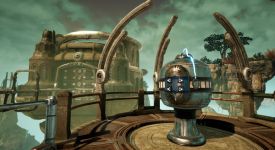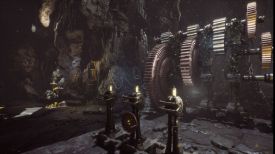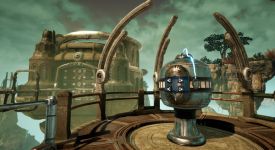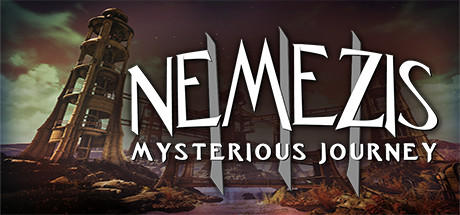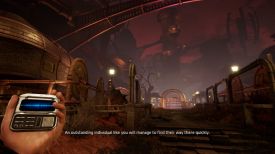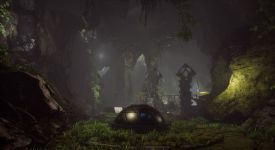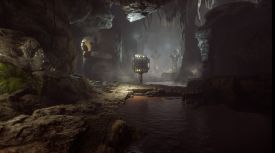|
By flotsam
Nemezis: Mysterious
Journey III
Detalion
The
III in the title is a giveaway that there are two earlier Mysterious
Journeys. The first was Schizm, released in 2001 and which I described
at the time as exceptional. The second, Chameleon, came two years later,
and it was different in ways that made it better and not as good, but
was ultimately a good bit of puzzling exploration. I remember both of
them, which I can’t say about every game that I played 20 years ago, and
I liked them a lot, Schizm especially. So I was very much looking
forward to this.
It
did though take me a while to get around to playing it. Don’t factor
that into anything about the game, rather it was a product of all the
other things that conspire to prevent you from doing other stuff. But a
window presented itself recently and I fired it up with appropriate
expectation and enthusiasm.
I
have to say it didn’t really meet them. On reflection, it was a sum of
the parts sort of thing.
The
look and sound and the 3D environment with complete freedom of movement
weren’t among those parts. The planet Regilus is a vibrant and
attractive place, and there is a ‘real world’ feel built by the sights
and sounds. The ‘mouse steer with W key locomotion’ is also my favourite
way to explore such places, and I was well pleased with all those
aspects.
I
wasn’t as taken with the voice acting, and the story less so. Amia and
her brother Bogard have come for a holiday at the Andromeda Hotel, but
have ‘transported’ there nowhere near each other and with a bunch of
puzzles to solve (??) in order to reach the hotel. You play each of them
throughout, but only ever one at a time (their was co-operative puzzling
in one of the earlier games) and not by your choice. Other stuff has
gone on, which you can uncover as you go, but the set up seemed a tad
contrived, and for me it never really overcame that.
Having said that, the story often doesn’t matter to me when the focus is
the puzzles, which I think it is fair to say is what this game is
primarily about. More of that later.
Voice-wise Amia was fine, if a little distant, but Bogard was excitedly
loud and invested yet somewhat wooden. The digital Guide (named
Emmanuel) I found largely intrusive. I
stopped listening if he wasn’t telling me things about a puzzle,
flicking my way through the dialogue to move on. People I came across
met the same fate, and while I activated each of the ‘story’ terminals I
found, I similarly stopped paying attention to their snippets.
The
puzzles though were what let me down the most.
There are quite a few, which by and large is a good thing, and some are
rather good, the rolling ball puzzle and the end game in particular.
However too many are tainted by poor mechanics, some fiddly design
elements, and/or a related tendency to inspire (and even require) trial
and error. Even the good ones suffer from some of that.
Take the rolling ball puzzle for instance. Push large metal balls around
a three-ringed platter, getting them into the correct spots. Work out
the what of the puzzle, then the how, then have at it. However I
couldn’t get a perspective from which I could view the whole puzzle and
formulate an overall plan of attack. I had to look at parts of the whole
separately, from which I drew my own top down diagram to guide my
efforts. That worked ok, and drawing stuff is a legitimate part of
puzzling, but for the sky rings that was impossible. I could again only
see the particular gate I was working on, but any sense of developing a
holistic plan was beyond me, and I just turned the rings piecemeal until
I got a result that was helpful. Which I had to do four times. Other
puzzles were solved in a similar way.
I
always acknowledge that perhaps I missed the obvious clue. So I will. I
do think though that the game sometimes conspired against utilising a
more logical approach.
That you might have to enter and exit the interactive mode throughout
the puzzle didn’t help. When exploring, things you can interact with
will generate a hotspot when you are close enough. Click and you will be
presented with a conventional mouse curser which you can use to engage
with the puzzle. The screen in front of you will be locked, although
holding the left mouse button allows you to change your view. If you
want to move from your position, in order to perhaps see a different
part of the puzzle canvass you need to back out of the puzzle and
re-engage.
I
confess that I didn’t become aware of the ‘left-mouse hold’ mechanic
until after I had done the rotating hut puzzle through a rather
laborious process of disengaging and re-engaging each time I wanted to
shift my view. That might be on me, although I swear it was Emmanuel who
told me about it at the rolling ball puzzle. Perhaps I should have
listened to him more attentively. The rotating rings puzzle though
required me to move quite a bit in order to see past structures.
There were times as well where I had to disengage, run and see what my
fiddling had done, take stock and come back and fiddle some more. The
huts is a case in point. Cause somewhere and effect elsewhere is again a
legitimate puzzle element, but here it irritated.
And
yet some puzzles are rather good at providing feedback. The final altar
puzzles for example will show you an image of each individual altar,
saving you from backtracking to remind yourself what the setup was, and
which helps significantly with the colour matching. Emmanuel provides
insights as well, and you can get hints if you play in normal made
(which may or may not be helpful) and the fact that you can solve things
through obstinate belligerency (as opposed to brain power) might
arguably be a plus.
Any
one of the things I found irksome about a puzzle might not have
mattered. Too many of them at once and throughout though led to an
overall feeling of an opportunity missed.
Which might just have been me, and which to some extent was a product of
my own anticipation.
More mundanely, you can save at will, and the game saves automatically
at various points, usually after solving a puzzle. Colour is present in
a number of puzzles. I didn’t find a way to reset a puzzle so tended to
save before engaging in case I wanted to start afresh.
Your own exploration might be encouraged through the ability to find
postcards, indicated by a little whirlwind, and which you can view
through the menu. As far as I know they served no other purpose than to
be found. You can tweak a bunch of settings, including whether to play
with subtitles.
It
might sound surprising but I did enjoy quite a lot of the time I spent
on Regilus. I just didn’t enjoy them as much as I had hoped I might.
I played on:
OS: Windows
10, 64 Bit
Processor:
Intel i7-9700K 3.7GHz
RAM: Corsair
Dominator Platinum RGB DDR4 32GB
Video card:
AMD Radeon RX 580 8192MB
GameBoomers Review Guidelines
December 2022
design copyright© 2022
GameBoomers
Group
 GB
Reviews Index GB
Reviews Index |
